
In this VFR - GPS Flight Plan we take off from the airport of Bahir Dar (HABD) [Ethiopia], fly towards the Simien Mountains, overfly Ras Dashen, the highest mountain of Ethiopia and finally land in the airport of Axum (HAAX) [Ethiopia]
At the bottom of this page you will find the download link of this Flight Plan (.PLN file)

In this VFR - GPS Flight Plan we take off from
the airport of Bahir Dar (HABD) [Ethiopia], fly towards the Simien Mountains,
overfly Ras Dashen, the highest mountain of Ethiopia and finally land in the
airport of Axum (HAAX) [Ethiopia]
Find below a short extract and screenshots of the main points of the route. In this journey around Africa I have used the Cessna 172S (Skyhawk)

Take off from the runway 22 of the airport of Bahir Dar.
Bahir Dar Airport (IATA: BJR, ICAO: HABD), also known as Dejazmach Belay Zeleke Airport, is an airport serving Bahir Dar, the capital city of the Amhara Region in Ethiopia. The name of the city and airport may also be transliterated as Bahar Dar. Bahir Dar airport is located 8 km (5 miles) west of Bahir Dar, near the Lake Tana. The airport also serves the Ethiopian Air Force.
It sits at an elevation of 5,976 feet (1,821 m) above mean sea level. It has one runway designated 04/22, with an asphalt concrete surface measuring 3,000 by 61 metres (9,843 ft × 200 ft). (*1)

After turning round we say goodbye to Bahir Dar and start flying above the
lake Tana.

Overflying the large lake Tana.

Dark clouds from a near storm.

Irregular terrain with many valleys. Notice that there are no longer big
woods from now on.

Flying near Debarq.
Debarq (Amharic: ደባርቅ) also spelled Dabareq and Debark, is a town in northern Ethiopia, 90 kilometers north of Gondar on the highway between Gondar and Axum and in the Semien Gondar Zone of the Amhara Region. It has a latitude and longitude of 13°08′N 37°54′E and an elevation of 2850 meters above sea level.
Debarq is the closest town to the Simien Mountains National Park, and is the location of the park headquarters.
Debarq's prosperity was due to its location on the Gondar-Massawa trade route; it is one of the stations on a route of the 1840s, according to a list compiled by Antoine Thomson d'Abbadie in his Geodesie d'Ethiopie. Richard Pankhurst notes that by the early 19th century its market was important enough to be one of six in Ethiopia requiring a nagadras ("head of the market") to oversee it and collect the fees. The revenue from taxes levied on the marketplace in the 1830s paid the governor of Semien province 3,000 Maria Theresa Thalers and about as much to the nagadras.
During a clash with his rebellious nephews, Emperor Tewodros saw his close friend and advisor John Bell killed in battle here in 1860. Although his nephews were killed in the skirmish, and their 1700 followers immediately surrendered, he exacted vengeance the next day by beheading all of their men.
The Tigrayan People's Liberation Front launched an offensive against the 603rd Army Corp of the Derg, and after destroying the government forces stationed at Debarq, they controlled the town 3 January 1989. (*1)
 |
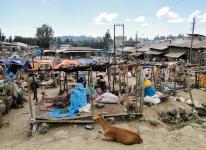 |
|
| Main street of
Debarq By Bernard Gagnon - CC BY-SA 3.0 |
Market in Debarq By Bernard Gagnon - CC BY-SA 3.0 |

Getting to the Simien Mountains National Park.
Simien Mountains National Park is the largest national park in Ethiopia. Located in the North Gondar Zone of the Amhara Region, its territory covers the highest parts of the Simien Mountains and includes Ras Dashan, the highest point in Ethiopia.
It is home to a number of endangered species, including the Ethiopian wolf and the walia ibex, a wild goat found nowhere else in the world. The gelada baboon and the caracal, a cat, also occur within the Simien Mountains. More than 50 species of birds inhabit the park, including the impressive bearded vulture, or lammergeier, with its 3-metre (10 ft) wingspan.
The park is crossed by an unpaved road which runs from Debarq, where the administrative headquarters of the park is located, east through a number of villages to the 4,430 metres (14,530 ft) Buahit Pass, where the road turns south to end at Mekane Berhan, 10 kilometres (6 mi) beyond the park boundary. (*1)
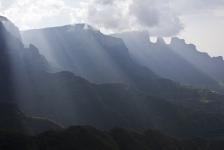 |
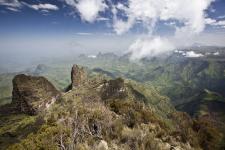 |
 |
| Simien Mountains By Hulivili - CC BY 2.0 |
Simien Mountains By Hulivili - CC BY 2.0 |
Geladas By Bernard Gagnon - CC BY-SA 3.0 |

Starting to ascend towards the Ras Dashen mountain.

Continuing the ascent.

Passing near the Ras Bwahit mountain.
Mount Bwahit (Amharic: ቧሒት ተራራ) (or Buahit, Bachit, Buiheat) is a peak of the Simien Mountains in the Amhara Region of Ethiopia. Its altitude is estimated at 4430 or 4437 m above sea level, making it the third highest mountain in Ethiopia and the 13th or 14th highest mountain of Africa. It is located about 16 km west of the highest Ethiopian mountain, Ras Dashen, from which it is separated by a 1,600 m deep gorge. The connecting ridge goes NNE over the Arkwasiye Pass (ca. 3635 m), eastwards over Kidis Yared, at 4,453 metres (14,610 ft) the second-highest mountain in Ethiopia, and SSE over the Metelal Pass at approximately 3730 metres above mean sea level to Ras Dashen. (*1)

Ras Bwahit mountain and the 1,600 m deep gorge that separates it from Ras
Dashen.

Getting to Ras Dashen, nearly at the limit of altitude of the Cessna 172S.

Overflying Ras Dashen.
Ras Dashen (Amharic: ራስ ዳሸን rās dāshn), also known as Ras Dejen, is the highest mountain in Ethiopia and fourteenth highest peak in Africa. Located in the Simien Mountains National Park in the Amhara Region, it reaches an elevation of 4,550 metres (14,930 ft).
The English form, "Ras Dashen" is a corruption of its Amharic name, "Ras Dejen", the term used by the Ethiopian Mapping Authority (EMA) which alludes to the traditional head or general who fights in front of the Emperor.
According to Erik Nilsson, Ras Dashen is the eastern peak of the rim of "an enormous volcano, the northern half of which is cut down about a thousand metres by numerous ravines, draining into the Takkazzi River." Its western counterpart is Mount Biuat (4,510 meters), separated by the valley of the Meshaha river. The mountain often sees violent snowfalls during the night, but given that day and night temperatures vary greatly, the snow is almost completely melted in a few hours (during the hottest period of the year), for the temperature may be over 5 degrees Celsius by midday. In winter snow falls rarely, since the majority of Ethiopia's yearly rainfall is in the summer, but if it does it usually lasts for weeks or months.
The first recorded ascent by a Eurasian was in 1841, by the French officers Ferret and Galinier. There is no verifiable evidence of earlier ascents by locals, but the summit climate and conditions are relatively hospitable, and there are nearby high altitude pastoral settlements. A small fort is still partially standing at around 4,300 metre SRTM data. (*1)
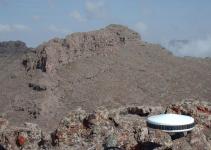 |
||
| The
summit area viewed from the west summit By Leonardo Pucci and Marco Vigano |

We say goodbye to the Ras Dashen and begin to descend.

An overview of the Simien massif while descending.

Approaching to our destination.

Final approach to the runway 34 of the airport of Axum.
Axum or Aksum, is a town in the Tigray Region of Ethiopia with a population of 66,800 residents (as of 2015). It was a popular town with international visitors until the Tigray War started in November 2020.
It is the site of the historic capital of the Aksumite Empire, a naval and trading power that ruled the whole region from about 400 BCE into the 10th century. In 1980, UNESCO added Axum's archaeological sites to its list of World Heritage Sites due to their historic value.
Axum is located in the Maekelay Zone of the Tigray Region, near the base of the Adwa mountains. It has an elevation of 2,131 metres (6,991 feet) and is surrounded by La'ilay Maychew, a separately administered woreda of the Tigray region. (*1)
 |
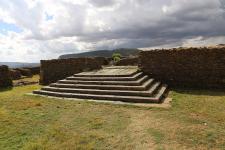 |
 |
| Building
supposedly containing the Ark of the Covenant at Maryam Sion church in Aksum By JensiS65 - CC BY-SA 3.0 |
Dungur
site By Sailko - CC BY 3.0 |
View from the
hill near Abba Pentalewon in Aksum By A.Savin - FAL |
You can download for free this Flight Plan but only for your own private use. It is strictly forbidden to share it or publish it in other sites, forums, newsgroups or in any other way . You are encouraged to share and publish links to this page only, but not direct links to the file itself.
(*1) Credits: The descriptive texts are mainly an excerpt of those provided by Wikipedia. Visit Wikipedia to read the full descriptions.
See other MS Flight Simulator flight plans and instructions
Disclaimer: These instructions and flight plan are intended to be used only for MS Flight Simulator and should not be used for real flights.